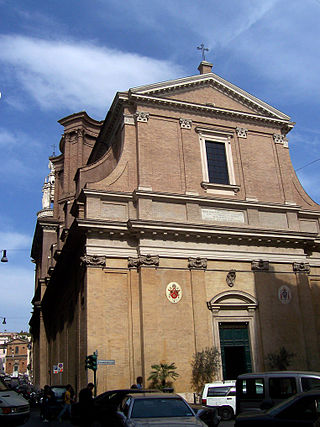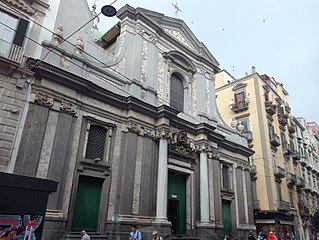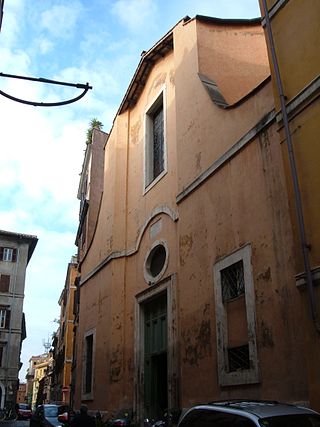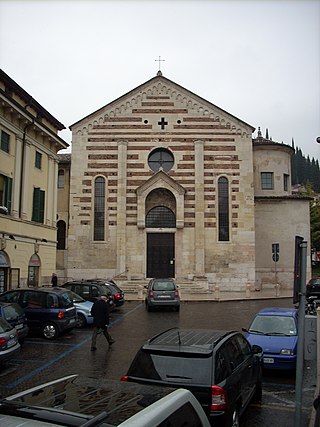History
It was built in 1645–50 with funds given by Olimpia Aldobrandini Pamphili, who (like St Francis) had roots in Calabria. It was designed by Giovanni Pietro Morandi, given to the Minim Friars, and became the national church of the Calabrians. The monastery was refurbished under Father Francesco Zavaroni di Montalto, General of the order, and using as an architect Luigi Berettoni. [1]
The late Baroque high altar was made by Giovanni Antonio de Rossi c. 1655 (who is also credited with the church's wooden tabernacle, set into a sculptured entrance of a military pavilion). [2] No new bell tower was built for the church - instead the 12th century Torre dei Margani was used, preserving its medieval coat-of-arms on the tower has been preserved.
However, the church as a whole was not consecrated until 10 July 1728, by Pope Benedict XIII. The lower part of the façade was refinished in plaster in the 18th century, and the whole church was then restored in 1826 by Pope Leo XII.
The recent titular cardinal-deacon of the church, from 21 October 2003 until his death was Renato Martino.

The Church of St. Ignatius of Loyola at Campus Martius is a Latin Catholic titular church, of deaconry rank, dedicated to Ignatius of Loyola, the founder of the Society of Jesus, located in Rome, Italy. Built in Baroque style between 1626 and 1650, the church functioned originally as the chapel of the adjacent Roman College, which moved in 1584 to a new larger building and was renamed the Pontifical Gregorian University. It is one of the great 17th century preaching churches built by Counter-Reformation orders in the Centro Storico.

The Church of the Gesù is the mother church of the Society of Jesus (Jesuits), a Catholic religious order. Officially named Chiesa del Santissimo Nome di Gesù, its façade is "the first truly baroque façade", introducing the baroque style into architecture. The church served as a model for innumerable Jesuit churches all over the world, especially in the central Europe and then in the Portuguese colonies. Its paintings in the nave, crossing, and side chapels became models for Jesuit churches throughout Italy and Europe, as well as those of other orders. The Church of the Gesù is located in the Piazza del Gesù in Rome and is one of the great 17th century preaching churches built by Counter-Reformation orders in the Centro Storico.

The Church of Santissima Trinità dei Monti, often called simply Trinità dei Monti, is a Roman Catholic late Renaissance titular church, part of a monastery complex in Rome. It is best known for its position above the Spanish Steps which lead down to the famous Piazza di Spagna. The church is entrusted to the Emmanuel Community, and is one of the five Francophone Catholic churches in Rome.

San Francesco a Ripa is a church in Rome, Italy. It is dedicated to Francis of Assisi who once stayed at the adjacent convent. The term Ripa refers to the nearby riverbank of the Tiber.

Sant'Andrea delle Fratte is a 17th-century basilica church in Rome, Italy, dedicated to St. Andrew. The Cardinal Priest of the Titulus S. Andreae Apostoli de Hortis is Ennio Antonelli.

Santa Maria in Vallicella, also called Chiesa Nuova, is a church in Rome, Italy, which today faces onto the main thoroughfare of the Corso Vittorio Emanuele and the corner of Via della Chiesa Nuova. It is the principal church of the Oratorians, a religious congregation of secular priests, founded by St Philip Neri in 1561 at a time in the 16th century when the Counter Reformation saw the emergence of a number of new religious institutes such as the Jesuits, the Theatines, and the Barnabites. These new congregations were responsible for several great preaching churches built in the Centro Storico, the others being Sant'Andrea della Valle (Theatines), San Carlo ai Catinari (Barnabites), and The Gesù and Sant'Ignazio (Jesuits).

San Francesco di Paola is a prominent church located to the west in Piazza del Plebiscito, the main square of Naples, Italy. The construction started in 1816 and ended in 1846.

Sant'Onofrio al Gianicolo is a titular church in Trastevere, Rome. It is the official church of the papal order of knighthood Order of the Holy Sepulchre. A side chapel is dedicated to the Order and a former grand master, Nicola Canali is entombed there. It is located on the Janiculum. Since 1946, the church has been under the care of the American congregation of the Franciscan Friars of the Atonement.

The Ss. Stimmate di San Francesco is a church in central Rome, Italy, in the Rione Pigna, sited where previously there was a church called Ss. Quaranta Martiri de Calcarario. It is located on Via dei Cestari, near the corner with Corso Vittorio Emanuele II and across the street and diagonal from the Largo di Torre Argentina.

San Nicola da Tolentino agli Orti Sallustiani is a church in Rome. It is referred to in both Melchiori's and Venuti's guides as San Niccolò di Tolentino, and in the latter it adds the suffix a Capo le Case. It is one of the two Roman national churches of Armenia. The church was built for the Discalced Augustinians in 1599, and originally dedicated to the 13th century Augustinian friar Saint Nicholas of Tolentino.

Onofrio Avellino was an Italian painter of the Baroque period.

San Gaetano, also known as Santi Michele e Gaetano, is a Baroque church in Florence, Italy, located on the Piazza Antinori, entrusted to the Institute of Christ the King Sovereign Priest.

The church of Santa Maria Assunta, known as I Gesuiti, is a religious building in Venice, Italy. It is located in the sestiere of Cannaregio, in Campo dei Gesuiti, not far from the Fondamenta Nuove.

The church of St. Nicholas the Charitable is a church located on via Toledo, almost midway between Piazza Carità and Piazza Dante in Naples, Italy.

The church of Santa Maria della Luce is an ancient church in the Rione of Trastevere in Rome, Italy.

The church of Santi Severino e Sossio and the annexed monastery are located on via Bartolommeo Capasso in Naples, Italy.

San Francesco di Paola is a Baroque style, Roman Catholic church located on Via Manzoni in Milan, Italy.

Santo Stefano is a Paleo-Christian, Roman Catholic basilica church in central Verona, region of Veneto, Italy.
Girolamo Massei was an Italian Mannerist painter active mostly in Rome.

San Giorgio is a Roman Catholic church located on the Piazza of the same name, just outside Porta Bruciata, in Brescia, region of Lombardy, Italy.




















